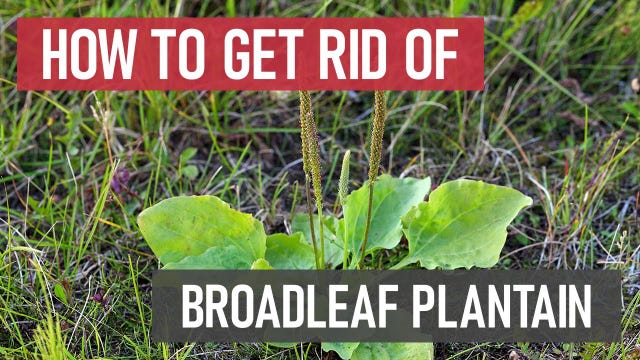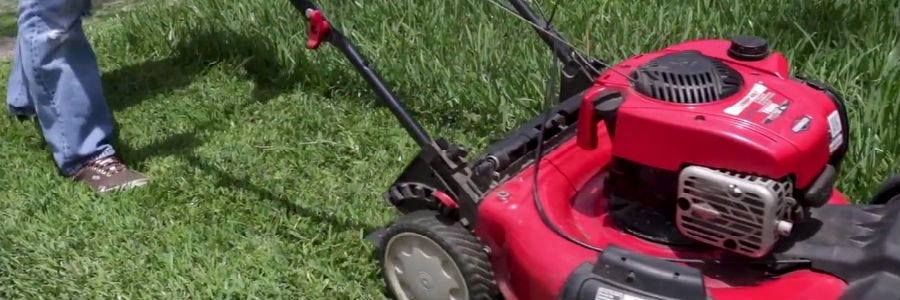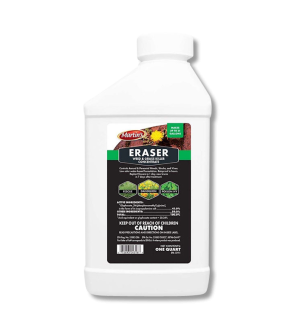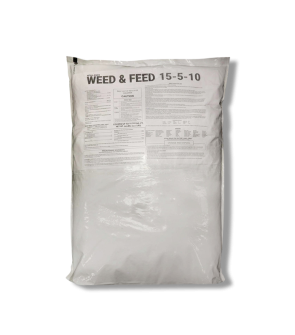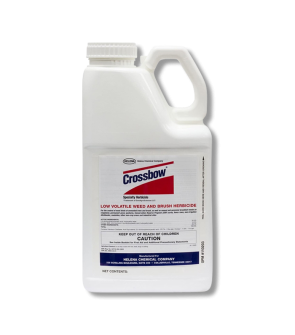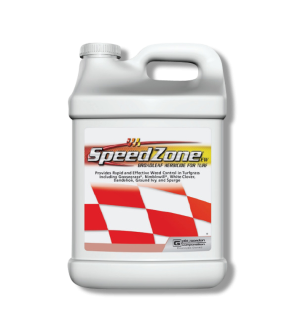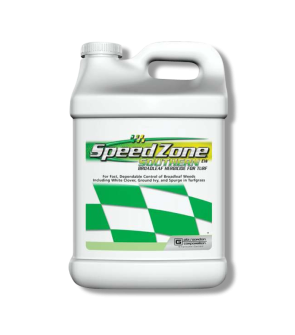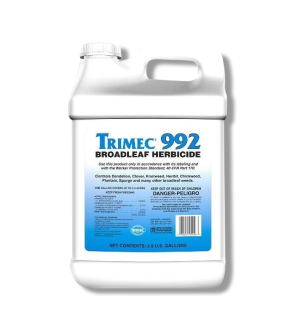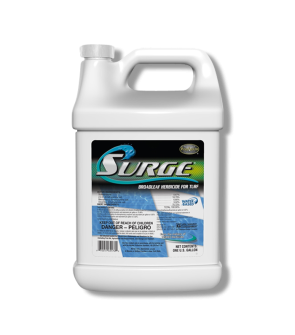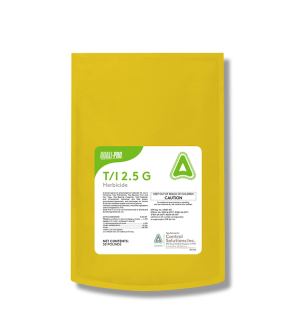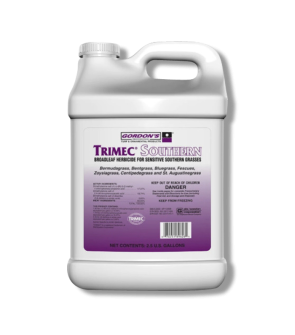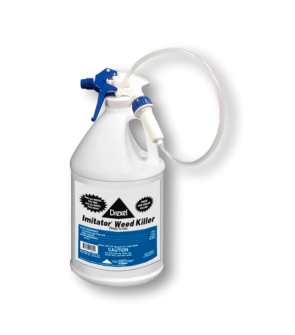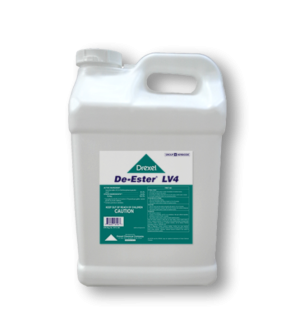Gain access to personalized product screening, the best pricing, rewards, and more!
Most Effective Products
Broadleaf Plantain Control: How to Get Rid of Broadleaf Plantain
Broadleaf plantain is a perennial weed, which means it can be a problem that will continue to torment you and your lawn year after year. Its characteristics are broad, oval-shaped leaves (unlike buckhorn plantain, which has long, narrow leaves) and, in the spring, tall flower spikes grow boldly towards the sky from the plant's center.
Broadleaf plantain doesn't discriminate when it comes to where it will put down roots. You are likely to find it between cracks in the sidewalk, along roadsides, in park areas, and in lawns or grassy areas that are not well-maintained. Even worse is that broadleaf plantain will grow without warning and take over sunny and shady spots (though the plant appears to prefer moist shade).
While plantains can be dug out of the soil as part of a treatment program to remove the weed from your yard, carrying that out—especially if you have a sizable outbreak—can be a chore. The easier route is to treat the weed with herbicides. Our step-by-step DIY guide will show you exactly what you need to kill broadleaf plantain and rid your yard of it while also saving money.
Identification
Before carrying out a treatment program, you must be certain you are dealing with broadleaf plantain, not some other weed. Careless identification can lead to using the wrong treatment methods, which can waste time and money.

- Broadleaf plantains grow in rosette formations: The leaves form a circular shape, all emerging from the same spot in the ground.
- The leaves are large and ovular in shape, with three to five prominent veins each. They will lie close to the ground.
- From the center, broadleaf plantains grow several stems that can be 2 to 7 inches in height. These stems produce many small green flowers, which develop into seed capsules as the plant matures.
Use the above description and image to help you identify the invasive plant you are dealing with and confirm that it is broadleaf plantain. If you are unsure, you can always contact us, and our lawn care experts will help you correctly identify the plant and suggest treatment options.
Inspection
After you have confirmed that you are dealing with broadleaf plantain, you can move on to inspection. During this phase, you will locate areas where broadleaf plantain is thriving and observe the conditions that allow it to thrive. This information will help you know where to focus your herbicide application.

Where to Inspect
Broadleaf plantain is a creeping spreading perennial weed that can grow in wet and compacted soil conditions with full sun or partial shade in lawns, gardens, nurseries, along roadsides and footpaths.
What to Look For
Broadleaf plantain typically emerges in late spring to fall, appearing as a low-growing rosette arrangement with egg-shaped leaves. From June to September, they develop flowers, and the leaves lessen, making the slender, tall stalks appear almost bare.
Treatment
Before using any herbicide product, make sure you wear the proper personal protective equipment (PPE) when mixing and applying any type of pesticide material.
Since handpicking these weeds is not usually effective, herbicides are the best approach. Non-selective herbicides or systemic herbicides containing one of the active ingredients glyphosphate, atrazine, bromoxynil, carfentrazone, dicamba, mesotrione, isoxaben, indaziflam, penoxsulam, sulfentrazone, triclopyr, or 2,4-D work best against broadleaf plantains.
We recommend using Eraser 41% Glyphosate Herbicide for spot applications in landscapes and 2,4-D Amine Selective Post Emergent Herbicide to control plantain in turf.
Broadleaf weed killers such as Eraser 41% Glyphosate Herbicide and 2,4-D Amine Selective Post Emergent Herbicide do a great job of controlling broadleaf plantain. The product goes down into the root system to kill the entire plant. Remember that Eraser 41% Glyphosate Herbicide is non-selective, meaning it will kill all vegetation that comes into contact with it.
Step 1: Measure the Treatment Area and Mix Herbicide
Eraser 41% Glyphosate Herbicide is a post-emergent herbicide designed to control various grassy and broadleaf weeds, including broadleaf plantain. It is a non-selective glyphosate product with no soil activity. This means that it will control and kill vegetation that it comes into contact with, so it is recommended to use it for spot treatments.
2,4-D Amine Selective Post-Emergent Herbicide is a systemic herbicide that controls post-emergent weeds in non-crop areas like lawns and ornamental turf. As a system, it travels down to the weed's root and kills it completely.
Determine how much product to use by measuring the square footage of the treatment area. To do this, measure the length and width of the treatment area in feet, then multiply them together (length X width = square footage).
To mix and apply to spot treatments, we recommend using a handheld pump sprayer for easier control during application.
To get rid of broadleaf plantain in landscapes, mix Eraser 41% Glyphosate Herbicide at a rate of 2 1/2 fl. oz. of product in one gallon of water per 300 sq. ft.
To remove this weed in ornamental turf areas, apply 3.16 pints of 2,4-D Amine Selective Post-Emergent Herbicide per 1 acre. For smaller applications, this breaks down to 1.1 fl. oz. of product applied over 1,000 sq. ft.
Fill the sprayer with half the amount of water, then add the measured amount of product. Lastly, pour the remaining water in, then agitate the sprayer until the solution is mixed with water.
When using a non-selective herbicide like Eraser, label your sprayer explicitly for Non-Selective Herbicide Use to prevent cross-contamination in the future.
Step 2: Apply Herbicide to Broadleaf Plantain

For 2,4-D Amine Selective Post-Emergent Herbicide applications, avoid mowing for 1 to 2 before and after application.
Lightly spray Eraser 41% Glyphosphate Herbicide just on the top of the leaf surface to the point of wetness, being careful of wind drift and runoff. Because Eraser 41% Glyphosate Herbicide is non-selective, it is recommended to use a shield, like a flattened cardboard box, to block the spray from contacting the desired vegetation.
To apply 2,4-D Amine Selective Post-Emergent Herbicide to this weed in turf, simply spray the top and bottom of the weed leaves. Make applications until the weed is wet, but not to the point of runoff.
When applied properly, affected weeds will turn yellow and begin to die. A follow-up application may be necessary if signs of recovery are observed, especially if the plant’s taproot is still alive—reapplication intervals with 2, 4-D Amine range from 21 to 30 days. A reapplication with Eraser 41% Glyphosphate may be made after 4 weeks.
For best results, we recommend making spot applications with these products in the spring or late summer to control broadleaf plantain. Applications are most effective when plants are newly emerged before flower formation.
Prevention
After eliminating broadleaf plantain from your property, you want to ensure it doesn't make a return. Some preventative measures you can take to prevent broadleaf plantain are listed below:
- The best defense against broadleaf plantain is a thick, lush lawn that is properly maintained and well-fed. A thick, dense, well-fertilized lawn will be better able to choke out broadleaf plantain weeds and not allow them room to establish. We recommend using Solutions 15-5-10 Weed & Feed Fertilizer with Trimec to achieve this. This slow-release fertilizer will provide the essential nutrients and fight against germinating broadleaf plantain in turf. For most applications, you must apply 3.2 to 4.0 pounds of product per 1,000 sq. ft. of treatment area. With a push or broadcast spreader, the granules are evenly distributed across the turf by first treating the outer edge of the treatment area. Next, walk steadily across the space that is missed in the middle. After 1 to 2 days have passed after application, you can then lightly water the granules to activate them.
- In addition to fertilizing, you can reduce the shade cast on your lawn by trimming overgrown shrubbery and tree branches, raking away leaf litter and picking up any debris, and employing a proper watering schedule to provide the local grass with enough water to strengthen its roots but not so much that it will encourage weeds. Many grasses require 1 inch of water every week. Apply the water all at once in the morning so it has time to seep into the ground without evaporating in the sun.
Key Takeaways
What is Broadleaf Plantain?
- Broadleaf plantain is a perennial broadleaf weed distinguished by its short, thick tap roots and leaves, which grow in a rosette.
How to Get Rid of Broadleaf Plantain
- We recommend Eraser 41% Glyphosate Herbicide and 2,4-D Amine Selective Post-Emergent Herbicide to treat broadleaf plantain as it is systemic and will kill the plant down to the root. Spot-treat the weeds, ensuring you do not get the herbicide on your desired vegetation.
Preventing Broadleaf Plantain Reestablishment
- To keep broadleaf plantain away, you must maintain a healthy, dense lawn by keeping up with cultural practices that will make it so your grass will choke out this weed from re-establishing. Regularly mowing, adjusting water, and applying the proper solutions 15-5-10 Weed & Feed Fertilizer with Trimec can do this.






